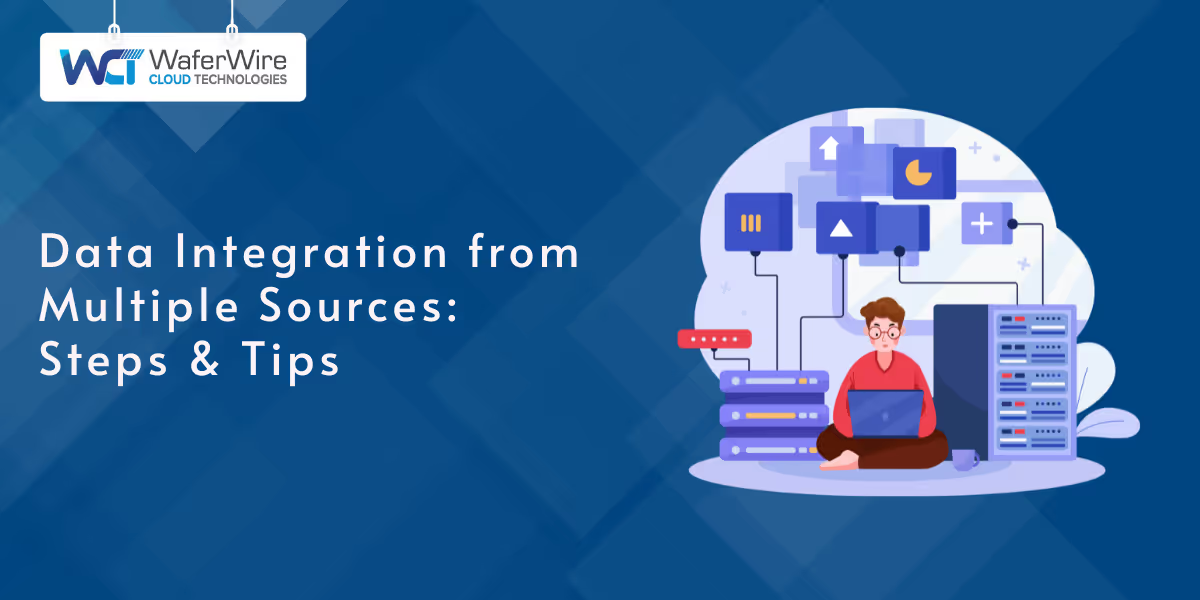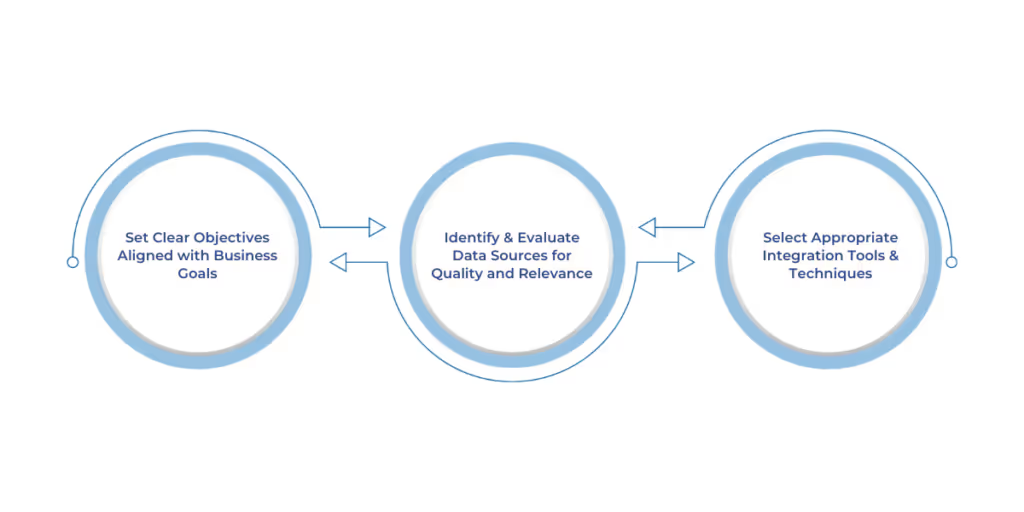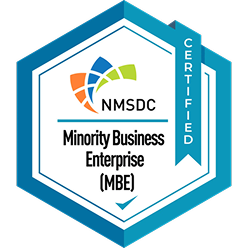

Consider the challenge of making business decisions when your information is spread across different systems—customer service data in your CRM, sales data in your ERP, and user behavior data from IoT devices. It’s like completing a puzzle without all the pieces in one spot. In our fast-paced, data-driven environment, businesses encounter a vast amount of data from numerous sources. Merging existing data with new sources is essential for realizing the full potential of this information, leading to clearer insights and quicker, more informed decisions.
So, how can organizations effectively consolidate all this information? Without a well-defined integration strategy, teams often face difficulties handling manual data or problems like duplicate data and misleading insights. The challenge is evident, but the answer lies in having the right strategy and infrastructure.
This blog will guide you through the steps and best practices for integrating data from various sources, showing how businesses can convert their data into actionable insights using data lakes and warehouses.
Data integration is the process of combining data from various sources into one unified view. This enables businesses to understand their operations, customers, and performance comprehensively. Whether merging data from legacy systems or integrating new data sources, a well-executed data integration strategy is essential for making informed decisions and driving growth. By centralizing data, companies can break down silos and ensure that all departments are working with the same information.
When integrating existing data with new data sources, companies often use ETL (Extract, Transform, Load) and ELT (Extract, Load, Transform) processes. Both methods are designed to move data from various sources into a central repository. The key difference between the two lies in the sequence of operations.
In both cases, these processes ensure that data is ready for use, whether for business intelligence, machine learning, or other analytics purposes.
Fragmented data can be a significant obstacle for businesses. When data is scattered across multiple sources, it’s difficult to gain a clear and accurate picture of performance. For example, a retail company might have customer information in one system, sales data in another, and inventory data in yet another. Without integration, it becomes challenging to understand how all these pieces of information fit together.
However, integrating existing data with new data sources can solve this problem. Centralized data enables a single source of truth, improving decision-making, reducing errors, and enhancing operational efficiency. Here, data integration can optimize the supply chain in manufacturing by linking production, inventory, and supplier data. This results in better resource allocation and faster response times.

The journey toward effective data integration begins with careful planning and strategic alignment, which ensures that integration efforts support broader organizational objectives rather than exist as isolated technical initiatives.
A successful data integration strategy must align with the organization's business goals. It should address key challenges, opportunities, and priorities that data integration can resolve. These goals may include facilitating mergers and acquisitions, eliminating data silos, leveraging new data sources, developing analytics capabilities, improving data accuracy, or streamlining processes.
By linking integration efforts to business outcomes, organizations can ensure their initiatives deliver real value. This alignment also helps secure stakeholder support, allocate necessary resources, and keep the focus on value creation. It prevents the mistake of pursuing technology for its own sake instead of improving business performance.
The next critical step is to conduct a comprehensive inventory of available data sources. These sources should be evaluated based on quality, relevance, accessibility, and compatibility with integration objectives. This assessment should examine data completeness, accuracy, consistency, timeliness, and conformance to business rules or industry standards.
Organizations must also consider the technical characteristics of data sources, including their format, structure, update frequency, and extraction mechanisms. By understanding the nature and condition of source data, integration teams can develop strategies to address quality issues and resolve inconsistencies. They can also prioritize sources based on their value to business objectives, ensuring integration efforts focus on the most impactful data assets.
Selecting the right integration tools and techniques is critical, as it depends on the organization's specific requirements, data characteristics, and technical environment. For example, choosing between ETL and ELT approaches depends on factors such as data volume, transformation complexity, processing needs, and target system capabilities.
Similarly, decisions about data consolidation, data federation, and change data capture should consider the organization's need for up-to-date data, access patterns, and analytics requirements. Modern integration platforms offer varying levels of automation, scalability, and flexibility. Selecting the right tools is important and can be challenging, as they must meet current needs and future growth plans. The chosen tools should support today's functionality while adapting to changing data and business requirements.
Now that we have covered the steps for effective data integration, it's time to focus on transforming raw data into valuable insights. The next phase—Data Preparation and Transformation—is where the real work begins to ensure your data is clean, accurate, and ready for analysis.
Data preparation and transformation are the most technically challenging aspects of data integration. They involve moving, cleansing, and restructuring data to create consistent information. These processes require careful planning and monitoring to ensure high-quality data. Here are the key steps to properly prepare and transform data for decision-making.
From simple file downloads to complex API interactions or database queries, the extraction process must be designed carefully to minimize the impact on source systems, meet data governance requirements, and capture necessary metadata along with the data itself.
Automation is key to making extraction processes reliable, repeatable, and scalable. It helps reduce manual intervention and minimize human error risks.
Modern data integration platforms offer advanced extraction capabilities, such as change data capture. This feature identifies and processes only modified data, reducing processing overhead and allowing for more frequent updates to integrated datasets. These capabilities are especially useful in environments with high data volumes or strict data freshness and availability requirements.
Once data has been extracted, it undergoes cleansing and transformation processes to address quality issues, standardize formats, and align with the target data model. This phase includes activities such as duplicate removal, missing value handling, outlier detection, format standardization, and unit conversion to create consistent, accurate data sets. The transformation process also involves more complex operations such as aggregation, derivation of calculated fields, merging related records, and resolving semantic differences between source systems.
These transformations are typically governed by business rules that define how data should be interpreted, standardized, and integrated. These rules ensure data sets accurately reflect business realities and support reliable analytics and reporting. The effectiveness of these cleansing and transformation processes directly impacts data quality and usability. This makes the phase particularly critical to the success of the overall integration initiative.
The final stage of the data preparation process involves loading the transformed data into the target repository. This could be a data warehouse, data lake, operational data store, or another specialized platform. The loading process must maintain data integrity, preserve relationships between data elements, and ensure the data meets the target system’s requirements and constraints.
For ETL processes, loading happens after transformation in a staging area. In contrast, ELT approaches load raw data first and then perform transformations within the target environment. In both cases, the loading process must be carefully managed. This minimizes disruption to existing data, maintains historical records where needed, and ensures efficient access to the integrated data.
Modern data platforms often offer specialized loading mechanisms. These are optimized for high-volume, high-velocity data ingestion, supporting real-time or near-real-time data integration for time-sensitive business processes.
With the data now prepared and transformed, the next crucial step is ensuring its governance and quality. Let’s explore how to maintain these standards throughout the integration process.
Data governance and quality management are crucial for a successful data integration strategy. These areas extend beyond technical data integration. They involve organizational structures, decision-making processes, and cultural factors that influence how data is managed throughout its lifecycle.
A comprehensive data governance framework defines data management's roles, responsibilities, and decision rights. It establishes accountability for data quality, security, and compliance and includes data access, usage, retention, and disposal policies. The framework ensures that integrated data is protected and used according to business needs and regulatory requirements.
Access controls are essential in data governance. They determine who can view, modify, or delete data based on their role and responsibilities.
Role-based access controls and detailed audit trails help protect sensitive information. They also ensure compliance with privacy regulations and maintain data integrity. These governance structures should be developed collaboratively, with stakeholders’ input. This provides a balance between security, compliance, accessibility, and usability.
Data quality doesn’t end once data is integrated. It requires continuous monitoring to ensure consistency and accuracy. Regular audits, data cleansing procedures, and automated validation checks help maintain high data quality over time.
In manufacturing industries, maintaining accurate inventory, production, and supplier status data is vital for operational efficiency. Ongoing monitoring ensures that this data stays accurate and up-to-date. Additionally, automated quality controls can help detect anomalies and data discrepancies, providing early warnings before they impact decision-making.
With a strong governance structure, we can now focus on the most popular data integration techniques that help streamline these processes effectively.
Effective data integration relies on various strategies and technologies to ensure seamless data access across different systems. Below are some key techniques businesses can leverage to improve their data integration efforts.
Data virtualization is a technique that allows businesses to access and query data from multiple sources without moving or replicating it. It creates a virtual view of data from disparate systems, allowing teams to work with data in real time. This is especially useful in environments where data is spread across various platforms but needs to be accessed quickly and efficiently without duplication or heavy data movement.
API-based integration is another important technique for connecting different systems. APIs (Application Programming Interfaces) facilitate the exchange of data in real time by allowing different applications to communicate with each other. APIs help integrate third-party services, cloud applications, and legacy systems, enabling businesses to seamlessly consolidate and access critical data.
Middleware is an intermediary layer that connects different applications, databases, or services. It helps simplify communication between disparate systems and ensures that data flows smoothly. Middleware can also automate data exchanges, synchronize information, and ensure compatibility between older and newer systems. This is particularly helpful for organizations with complex IT environments that include a mix of legacy and cloud-based systems.
Data federation allows businesses to integrate data from multiple sources without physically combining them. It creates a virtual database that unifies data access across different systems. This method eliminates the need for duplicating or moving large datasets and enables users to query data across multiple sources as a single entity. Data federation is particularly valuable when businesses need real-time access to data from diverse systems but do not want to risk the complexities of traditional data warehousing.
After examining these widely used data integration methods, we can now focus on tackling typical obstacles to enhance their data integration workflows.
Integrating existing data with new data sources presents a variety of challenges. Many businesses find it difficult to consolidate and manage data across diverse systems. Addressing these obstacles is crucial to unlocking the full value of the integration process.
One of the most common challenges when integrating data is ensuring system compatibility. Data may come in different formats or structures, making it difficult to merge effectively.
To overcome this, businesses must establish a data format standard before integrating. This includes setting up data transformation rules that align and clean data from multiple sources. Tools like data quality software and automation can also help identify and correct issues quickly. Prioritizing data compatibility and quality will ensure a smoother integration process.
Legacy systems often pose a significant challenge when integrating existing data with new data sources. Many organizations still rely on outdated systems that are not easily compatible with modern cloud-based technologies.
Planning for phased upgrades or migrations is the key to overcoming this challenge. While replacing legacy systems may be costly and time-consuming, organizations can gradually move critical data and processes to more modern ones. Another effective solution is using middleware or APIs to bridge legacy systems and new platforms.
Data preparation is a foundational step in the integration process, but it’s not always executed systematically. Companies often struggle with inconsistent data entry, poor documentation, and unstructured datasets. These issues can make it difficult to integrate data effectively and lead to misleading insights.
Establishing strong data handling procedures is essential. This includes setting up standardized processes for data entry, using data governance frameworks, and conducting regular audits to check for data integrity. Additionally, ensuring that teams are properly trained to handle data consistently will improve the overall efficiency of the integration process.
Let’s explore key strategies for effective data integration. These approaches will streamline the process and ensure successful outcomes.
A successful data integration strategy goes beyond just technical execution. It requires careful planning, automation, and continuous improvement to ensure that your organization’s data drives meaningful business outcomes.
Data integration is crucial for businesses to maximize their data potential. By following the right strategies and best practices, companies can merge existing data with new sources to drive better decisions and growth. A structured approach is necessary—aligning integration with business goals, automating where possible, and continuously monitoring data quality.
A clear, ongoing strategy is vital for maintaining a scalable, future-ready data system.
WaferWire helps businesses streamline this process. We specialize in integrating existing data with new data sources and offer full support from strategy to implementation. Our tailored solutions ensure your data is secure, accessible, and ready for growth.
Let’s turn your data into a powerful asset. Reach out to us today to transform your data integration strategy.

